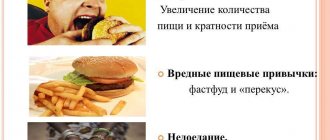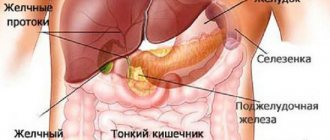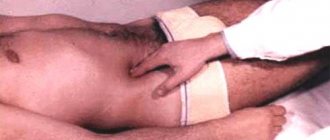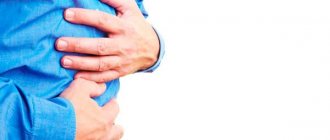The pain that torments a person can be of a varied nature. Particular attention is paid to girdle pain in the hypochondrium - this is a condition that occurs with varying degrees of intensity: short-term, prolonged or paroxysmal.
If pain occurs in the hypochondrium, this may be a signal for the occurrence of diseases of the internal organs, for example, ulcerative lesions of the duodenum, pancreatitis, and stomach diseases.
What hurts?
Girdle pain in the hypochondrium is a symptom of various diseases
Girdle pain in the hypochondrium can be a sign of acute or chronic diseases of the internal organs of various etiologies. In order to be sure which doctor can cure this condition, you should pay attention to the accompanying symptoms. Such pain may be a symptom of the following ailments:
- Gastritis
- Ulcers
- Oncological neoplasms in the stomach, pancreas and intestines
- Acute or chronic pancreatitis
- Cholecystitis
- Biliary dyskinesia
- Hepatic colic
- Hepatitis A
- Cirrhosis
- Abscesses and injuries
- Heart disease, including heart attack
In order to recognize the disease, you need to try to more accurately determine the location of the pain: under the ribs on the right or left; where does it give off: to the left or right shoulder blade, collarbone. You should pay attention to the nature of the pain:
- Aching
- Shooting
- girdling
- Cutting
- Blunt
- Unbearable
- Worsened by sudden turns, coughing
In addition to these factors, the fact that the pain occurs can help determine the disease: whether it is associated with food intake, and at what time of day it occurs. Help in diagnosing the disease can be provided by the symptoms that accompany underwear sensations:
- Nausea
- Vomit
- Heartburn
- Bitterness in the mouth
- Increased body temperature
Preventive measures
To prevent the development of these diseases, you must adhere to the following recommendations:
- eat rationally, including foods rich in vitamins and minerals in the daily menu;
- Avoid overeating and eat as light a meal as possible at night;
- to live an active lifestyle;
- prevent injuries in the abdominal area, and if they occur, immediately consult a doctor;
- engage in sports or exercise.
If you have chronic diseases, you must constantly see a doctor and follow all his recommendations. This will prevent the exacerbation of ailments that lead to serious consequences.
When urgent hospitalization is necessary
Girdle pain in the hypochondrium can be of varying intensity
Acute girdle pain under the ribs in the middle can be a symptom of a stomach or duodenal ulcer. Many patients compare this condition to being hit by a dagger, which is why the pain is called dagger pain. The patient cannot find a place for himself and to alleviate this condition he is forced to take a lying position with his legs bent towards his stomach.
At first, the pain is felt “in the pit of the stomach”, then it shifts to the right - this is explained by the fact that the contents of the stomach flow to this side, which can even enter the abdominal cavity. During an attack of an ulcer, you should not hesitate and urgently call an ambulance, since inaction in this situation can lead to peritonitis.
As a rule, such an attack is preceded by a long history: chronic ulcerative lesions. An acute perforated ulcer can develop only after surgery, trauma or sepsis. The patient must be urgently hospitalized in the surgical department of gastroenterology.
Main symptoms and syndromes of digestive diseases
digestive diseases
| Make an appointment | Make an appointment by calling +7 (812) 600-67-67 or filling out the online form - the administrator will contact you to confirm your appointment |
UNION CLINIC guarantees complete confidentiality of your request.
A symptom is a sign, i.e., a manifestation of a disease.
A syndrome should be understood as a set of symptoms of a particular disease. There are symptoms of a subjective (complaints) and objective (signs) nature. Symptoms and syndromes are the basis for constructing a diagnosis. However, the causes of most symptoms and syndromes may not be one disease, but a wide variety of diseases. Therefore, in all cases, consultation with a doctor is necessary; self-medication is unacceptable. PAIN IN THE ABDOMINAL AREA Pain in the abdominal area is one of the most common and important symptoms indicating diseases of the digestive system. There are somatic and visceral pain. Somatic pain is caused by irritation of superficial tissues supplied with sensory nerves, i.e. skin, subcutaneous tissue and peritoneum. As a rule, it is acute in nature with strict localization at the site of irritation. Visceral (internal) pain is formed by irritation of the abdominal organs; it is usually dull, without a specific localization. Thus, many factors are involved in the formation of pain: damage to organ tissue, irritation of their nerve endings, nerve conductors, spinal cord and brain. The causes of pain are a variety of diseases of the abdominal organs: hepatic colic (cholelithiasis), gastric and duodenal ulcers, tumors of the stomach, intestines and pancreas, dyskinesia of the biliary tract and intestines, chronic inflammation of the liver, gall bladder, pancreas, intestines, kidneys, bladder, uterus and its appendages. Sources of pain can also be diseases of the abdominal wall itself (hernias, wounds, inflammation). Particularly alarming are pains caused by diseases such as perforation of stomach ulcers, duodenal ulcers, intestinal obstruction, acute cholecystitis, acute pancreatitis, acute appendicitis, inflammation of the peritoneum - peritonitis, etc. It is no coincidence that these diseases are united under the name “acute abdomen”, since they require emergency surgery. Therefore, if pain in the abdominal area occurs, urgent consultation with a doctor is necessary. Acute abdomen is a collective term and characterizes the situation of a catastrophe in the abdominal cavity with an unknown cause. Symptoms of an acute abdomen can occur with any surgical disease of the abdominal organs, as well as with trauma. From a diagnostic point of view, the following characteristics of pain are of great importance: localization, nature, intensity, duration of a painful attack and its development, frequency, rhythm of pain, factors that intensify and weaken pain. The localization of pain to a certain extent allows us to judge the damage to a particular organ. Pain in the epigastric region is observed in diseases of the diaphragm, stomach, duodenum, pancreas, transverse colon, hernia of the white line of the abdomen. Pain in the right hypochondrium occurs with diseases of the gallbladder and bile ducts, liver, head of the pancreas, duodenum, hepatic curvature of the colon, right kidney. Pain in the left hypochondrium appears with lesions of the stomach, pancreas, spleen, left half of the colon, left kidney, diaphragm, left lobe of the liver. Pain in the upper abdomen (girdling nature) is typical for damage to the pancreas and diaphragm. In the peri-umbilical region, pain occurs due to diseases of the small intestine, mesenteric lymph nodes, omentum, and abdominal wall hernias. Pain in the right iliac region is characteristic of inflammation of the appendix (appendicitis) and the cecum. Pain in the left iliac region is associated with diseases of the left half of the colon, left kidney, ureter and uterine appendages. Pain localized in the suprapubic region is caused by bladder disease or inguinal hernia. Diffuse pain, covering the entire abdominal area, can occur with extensive inflammation of the peritoneum (peritonitis), adhesions (intraperitoneal adhesions), intestinal obstruction, and often with significant accumulation of air or fluid in the abdominal cavity. However, the localization of pain is of relative diagnostic importance, since pain often does not occur in the area of the affected organ, but in places of irradiation, that is, it is projected to other parts of the abdomen. Moreover, some diseases of the thoracic cavity (myocardial infarction, lobar pneumonia, pleurisy) can be a source of pain in the upper abdomen. Clarifying the nature of the pain has a certain diagnostic value. A burning sensation indicates irritation of the mucous membrane of the esophagus, stomach or duodenum. Dull, pressing pain is characteristic of an enlarged liver, tumor, cyst, prolapse of organs, accumulation of air or fluid in the abdominal cavity. Compressive (colicky) pain is felt with increased tone of the smooth muscles of the abdominal organs. There are biliary, renal and intestinal colic. The cause of biliary colic is most often the passage of stones through the bile ducts. Pain during gallstone crises is one of the most intense of all possible pains. As a rule, an attack of biliary colic occurs after errors in the diet, especially after eating fatty, fried foods. The pain is usually localized in the epigastric region and right hypochondrium, radiating to the right shoulder and scapula. Nausea almost always accompanies biliary colic, and jaundice often develops. Renal colic usually occurs with urolithiasis. The pain is mainly localized in the kidneys and abdomen, radiating to the back and lower abdomen, accompanied by frequent painful urination and the appearance of blood in the urine. With intestinal colic, pain spreads throughout the abdomen, causing bloating, rumbling, and stool disorders. Piercing (“dagger”) pains are observed with a perforated gastric or duodenal ulcer, pancreatic cancer, acute intestinal obstruction, peritonitis, ectopic pregnancy, etc. The irradiation of pain has greater diagnostic value than simply its localization. Here are typical directions of pain irradiation:
- pain radiates upward from the epigastric region during processes in the lower part of the esophagus or in the upper part of the stomach;
- pain radiates to the right hypochondrium in case of gastric outlet ulcer, duodenal ulcer, diseases of the biliary tract and head of the pancreas;
- pain radiates under the right shoulder blade due to gallbladder disease;
- pain radiates to the left hypochondrium or under the left scapula from the body and tail of the pancreas, with a stomach ulcer, colon tumor;
- pain may radiate to the shoulder due to diseases of the diaphragm, acute pancreatitis, acute cholecystitis and cholelithiasis;
- pain in gynecological diseases radiates to the sacrum;
- pain radiates to the groin area from the kidneys and ureters.
The duration of pain is more characteristic of the type of disease than of the organ. The pain caused by a cramp lasts seconds or minutes; pain when irritating the mucous membrane or when passing stones - hours; for inflammation - days; for ulcers - weeks. An important diagnostic sign is the frequency of pain. Irregular paroxysmal (colic) pain is typical for cholelithiasis and urolithiasis. Colic is a pain that comes and goes rhythmically. Constant pain usually occurs due to diseases such as adhesions, tumors, etc. The dependence of pain on the intake and nature of food has a certain diagnostic significance. Thus, with lesions of the esophagus, pain occurs during meals, with diseases of the stomach - after 15-30 minutes, with diseases of the duodenum - 1-2 hours after eating. Pain at night, as well as pain that goes away after eating (“hunger pain”) or alkalis, occurs with increased acidity of gastric juice. The appearance of pain after eating fatty, fried foods is characteristic of gallbladder diseases, and spicy foods are characteristic of gastric and duodenal ulcers. Defecation relieves pain almost always with simple constipation, but often with spastic constipation. On the contrary, with irritable colon and functional diarrhea, bowel movements can increase pain. Body position plays a role in hiatal hernia: pain is caused by bending forward, especially in a supine position. Therefore, it is typical for the pain to appear at night and relieve after straightening. With kidney stones, pain is provoked by shaking when moving (riding on a tram, bus, etc.). The dependence of pain on body position is characteristic of spinal lesions. If pain in the epigastric region appears when walking, then angina pectoris is suspected. A common mistake is the idea that abdominal pain is caused only by an organ located in close proximity to the location of the pain. Such a coincidence is only partial, since there are possible types of pain in the abdominal area that have nothing to do with the abdominal organs at all. Based on their nature and origin, the following types of pain in the abdominal area are distinguished:
- radicular pain that occurs due to compression of sensitive spinal roots (nerves) by deformed vertebrae (spondylosis);
- pain caused by diseases of organs not related to the digestive system and general diseases (diseases of the spleen, some acute infectious diseases, diseases of the blood vessels of the abdominal organs, renal pelvis and ureters, inflammation of the ovaries and their appendages, inflammation of the lungs and pleura, poisoning with lead, mercury and arsenic, angina pectoris, myocardial infarction, etc.). This group of diseases is very extensive. The origin of pain here is different. Usually we are talking about either radiating pain from organs with similar radicular innervation (for example, from the organs of the chest cavity), or about secondary visceral pain that occurs reflexively in a healthy organ;
- pain in the nerve plexuses, especially in the solar plexus of the abdominal cavity;
- neuropathic pain in neurotics and psychopaths.
You should know that the patient’s reaction to pain depends not only on the type and intensity of the lesion, but also on the threshold of sensitivity and on the interpretation of the sensation. Sensitivity to the perception of pain varies from person to person in terms of both intensity and pattern. Some people, with the same impulse, experience only a slight unpleasant sensation, others experience a feeling of burning, cutting, nausea, and still others experience unbearable pain. Pain sensitivity increases during menstruation, pregnancy, menopause, and increased nervous activity. In practice, the state of higher nervous activity is very important. Some individuals are characterized by increased sensitivity to pain, which usually “goes along” with increased emotionality. The diagnostic significance of pain increases significantly when it is compared with other clinical and laboratory data. NAUSEA Nausea is an unpleasant sensation in the epigastric region, weakness, often accompanied by lightheadedness, drooling, pale skin, sweating, dizziness and even fainting. The patient experiences an aversion to food, sometimes feels numbness and a crawling sensation. Blood pressure decreases, and sometimes fainting occurs. Nausea often precedes vomiting. Nausea is associated with the manifestation of functional insufficiency of the stomach (decreased motor activity, decreased secretion of gastric juice). The mechanism of its occurrence is not precisely known. It is believed that irritation of the vagus and splanchnic nerves with subsequent excitation of “emetic nervous vomiting psychogenic” or “habitual” vomiting is of great importance. Other simultaneously occurring symptoms can help in recognizing the cause of vomiting: vomiting in serious organic diseases is accompanied by weight loss; on the contrary, with functional vomiting, it is noted that patients do not lose weight and have a healthy appearance, contrasting with severe nausea. In diseases of the abdominal organs, vomiting is more often observed with narrowing (stenosis) of the gastric outlet, acute cholecystitis, chronic pancreatitis and biliary colic. In case of acute onset of vomiting, acute abdomen syndrome should first be excluded. The cause of vomiting can be judged by the following indicators: the causing impulse, the state before vomiting, the time and frequency of occurrence, the nature, smell and color of the vomit. In diseases of the digestive organs, nausea and abdominal pain occur before vomiting. On the contrary, vomiting without nausea is characteristic of brain damage (trauma, tumor, etc.). Vomiting during or immediately after eating is usually functional. Late pain, 1.5-3 hours after eating or at night, is characteristic of a duodenal ulcer. Morning vomiting, before breakfast, often indicates a toxic cause (alcohol) and pregnancy. When the esophagus is narrowed, the vomit consists almost entirely of undigested food. Vomiting on an empty stomach, combined with symptoms of gastric discomfort, is typical for chronic gastritis. With a peptic ulcer, vomiting usually occurs against the background of severe abdominal pain and relieves it. The smell of vomit may primarily indicate that it contains acidic gastric juice. With intestinal obstruction, vomit has a disgusting smell. Vomiting of bile, which does not bring relief and is accompanied by transient jaundice, often occurring after eating fatty foods, is typical for diseases of the liver, biliary tract and pancreas. The admixture of blood in the vomit gives it a color from bright scarlet to dark brown, almost black (the color of “coffee grounds”), which depends on the degree of bleeding from the digestive organs and the duration of contact of the blood with the acidic contents of the stomach. Consequently, vomiting is a rather serious symptom, a kind of alarm signal that requires urgent consultation with a doctor. In addition, vomiting also leads to serious consequences, such as loss of fluid, important salts, and impaired renal function. JAUNDICE Jaundice is the yellow discoloration of the skin, sclera of the eyes and mucous membranes due to the deposition of bile pigment (bilirubin) in the tissues. An early sign of jaundice is yellowness of the sclera of the eyes. Bilirubin is formed from hemoglobin during the destruction of red blood cells (erythrocytes) in the spleen and in a special system called the reticuloendothelial system. Next, bilirubin enters the liver, where through complex biochemical transformations it acquires a soluble form. This bilirubin, produced in the liver, is secreted by bile and enters the intestines with it. It is partially absorbed in the intestine, but is mainly excreted in the feces. Thus, a wide variety of organs and systems take part in the exchange of bilirubin (blood, liver, intestines). The bile ducts are of great importance, the normal patency of which ensures a good outflow of bile. Jaundice is a serious syndrome indicating the presence of a serious illness. The causes of jaundice are very diverse. Determining the type of jaundice is critical to making a diagnosis and choosing treatment. In practice, various types of jaundice are grouped into four groups: hemolytic, hepatic, mechanical and congenital. Brief characteristics of various types of jaundice.
- Hemolytic (prehepatic) jaundice. It develops due to increased formation of bilirubin with accelerated breakdown of red blood cells. Hemolytic jaundice is not a disease of the liver, but of the blood system. The reasons for its development are varied; these are mainly various intoxications, including occupational and medicinal ones. From this true jaundice it is necessary to distinguish false jaundice, which occurs when a number of drugs are ingested (acriquine, picric acid) and is not a consequence of the deposition of bilirubin in the tissue. Hemolytic jaundice is characterized by a combination of yellowness and pallor of the mucous membranes due to developing anemia (anemia).
- Hepatic (parenchymal) jaundice. This jaundice develops due to damage to the liver cells, their inability to secrete bilirubin. As a result, the latter is deposited in tissues, and the amount of bilirubin in bile and feces decreases. But there is a lot of it in the urine, which becomes dark, sometimes resembling the color of dark beer. Hepatic jaundice is observed in acute and chronic hepatitis, toxic, medicinal, alcoholic liver damage, liver cirrhosis, and some infectious diseases. Hepatic jaundice is characterized by an enlarged liver and spleen. At the same time, general weakness, apathy, irritability, sleep disturbance, lack of appetite, nausea, vomiting, intestinal dysfunction appear, and signs of liver failure increase.
- Mechanical (subhepatic, obstructive) jaundice. It is caused by an obstruction to the flow of bile from the bile ducts into the duodenum. As a result, bile stagnates and bilirubin passes through the liver cells into the blood. The consequences are the same as for hepatic jaundice. Characteristic is the appearance of itching of the skin, and in case of complete obstruction of the bile ducts, discolored (light) feces. Obstruction to the flow of bile is caused by stones (cholelithiasis), worms, chronic pancreatitis, tumor of the head of the pancreas, etc.
- Familial, congenital jaundice. They constitute a group of conditions that are characterized by damage to many family members and a benign course of the disease process.
Recognition of the type of jaundice is possible only with a thorough analysis of all clinical data and the use of laboratory tests. Therefore, if jaundice appears, urgent consultation with a doctor is necessary. It should be remembered that the fate of the patient depends on this. For example, in some cases, obstructive jaundice requires emergency surgical intervention. Among patients with hepatic jaundice there may be patients with acute (viral) hepatitis who pose a danger to others (threat of infection). In these cases, hospitalization in infectious diseases hospitals is necessary.
BLEEDING FROM THE DIGESTIVE ORGANS The digestive tube provides many opportunities for bleeding: its source can be not only organic diseases, such as ulcers or tumors, but also the mucous membrane itself, or due to local or general causes. The danger of bleeding from the gastrointestinal tract is obvious. The special nature of the bleeding is as follows: firstly, it occurs frequently, secondly, it can be large, acute and life-threatening, and thirdly, its source is not easy to determine, since the digestive tube is long. Basically, one can distinguish between external bleeding and hidden bleeding. With external bleeding, a distinction is made between vomiting blood, defecation of digested blood and defecation of undigested blood. When vomiting blood, the latter accumulates in the stomach or flows here from the esophagus, or enters as a result of backflow from the duodenum. Under the influence of hydrochloric acid in the gastric juice, the blood in the vomit turns brown, like coffee grounds. But if the bleeding is rapid, then the blood is released from the stomach through vomiting before it has time to mix with the gastric contents, and retains its natural appearance. Defecation of digested blood indicates a higher located source of bleeding (stomach, upper intestines). In this case, the blood is digested by enzymes in the intestines as protein food; the digestion products give the stool a black color and irritate the intestines, causing accelerated movement of the contents through it. Consequently, the feces will be mushy, sticky, black, “like tar,” “like wheel ointment.” When defecating undigested blood, the stool is stained with scarlet blood, and the source of bleeding is usually located in the lower intestines, for example due to hemorrhoids. If the total blood loss is less than 350 ml, the patient usually feels the urge to defecate and produces tarry feces. There are either no subjective sensations at all, or they are limited to mild transient nausea, chills, and weakness. With a large loss of blood, nausea, sweating, tinnitus, ripples in the eyes, weakness, and fainting appear. The patient is pale, sweating, the pulse is rapid, the blood pressure is low, i.e., in fact, a picture of acute anemia (anemia) develops. Acute esophageal bleeding manifests itself suddenly in the form of bloody vomiting, and the blood in the vomit is usually scarlet. Esophageal bleeding is observed in many diseases of the esophagus (ulcers, diverticula, disintegrating tumors, trauma, foreign bodies, etc.). Acute gastric bleeding is manifested by bloody vomiting and tarry stools. The clinical picture is heterogeneous, as it is associated with the massiveness and duration of bleeding. Clinical manifestations range from mild dizziness, sudden weakness to loss of consciousness. Bleeding can occur as a result of destruction of the vascular wall, acute inflammation with the development of erosions. The causes of stomach bleeding are varied. These include erosive gastritis, hiatal hernia, peptic ulcer, cancer, polyps, etc. The causes of intestinal bleeding are duodenal ulcer, polyps, intestinal cancer, ulcerative colitis, dysentery, hemorrhoids, anal fissures, etc. Excess blood is excreted through the anus in the form of tarry stool when the source of bleeding is localized in the upper intestines and scarlet blood in the lower intestines. It should be noted that there are more rare causes of vomiting blood and tarry stools. For example, swallowed blood after a nosebleed during sleep. Hepatic and obstructive jaundice are often accompanied by increased bleeding due to impaired liver function. Finally, the causes of gastrointestinal bleeding can be various painful conditions in which there are no diseases of the digestive system. Thus, this is facilitated by vitamin deficiency, blood diseases (hemophilia, polycythemia, Werlhof's disease), vascular diseases (increased permeability of their walls for blood to escape). The most common medications that cause bleeding are salicylates and aspirin. The appearance of bloody vomiting or the presence of blood in the stool (scarlet or black) are serious symptoms and therefore, if they occur, urgent medical attention is required. ASCITES Ascites is the accumulation of fluid in the abdominal cavity, which is manifested by heaviness in the abdomen, bloating and enlargement. The mechanisms of development of ascites vary depending on the nature of the underlying disease. The possible causes of ascites are: inflammation of the peritoneum, venous congestion, obstruction of lymph flow, cancerous lesions of the peritoneum, penetration of bile or blood into the abdominal cavity. The mechanisms of development of ascites are complex and not fully understood. They highlight
| Make an appointment | Make an appointment by calling +7 (812) 600-67-67 or filling out the online form - the administrator will contact you to confirm your appointment |
UNION CLINIC guarantees complete confidentiality of your request.
How does acute pancreatitis manifest?
The disease occurs suddenly, the pain radiates to the shoulder blades and affects the entire upper abdominal region. Pancreatitis is characterized by pain under the ribs on the right.
- The pain does not change during coughing, sneezing and moving from a lying position.
- The following accompanying symptoms will help diagnose this disease:
- Morning sickness
- Continuous vomiting
- Weakness
- Stool disorders
- Dizziness
The pain cannot be relieved even with strong painkillers. Very often the patient is bothered by loose stools with pieces of undigested food and an unpleasant odor. The color of the stool changes - it becomes gray. The patient experiences belching with an unpleasant odor and a bitter taste in the mouth.
With pancreatitis, under the influence of a number of factors, the pancreas is disrupted and becomes inflamed. For example, if a stone gets into the bile duct and interferes with the free outflow of bile: the pressure inside the duct increases and activation of digestive enzymes occurs. These enzymes, without contacting food, begin to work with the mucous membrane of the gland, thus destroying it and causing inflammation. Symptoms characteristic of this condition are:
- Blue discoloration of the skin
- Hemorrhages in the navel area in the form of red dots
- In severe cases, the patient's blood pressure drops sharply, which can even lead to death.
Very often, this condition occurs after excessive alcohol consumption or overeating, as well as after eating fatty foods. In the medical community, such an attack is characterized as festive.
Pain in the hypochondrium with acute cholecystitis
Girdle pain in the hypochondrium is a reason to consult a doctor!
Pain in the hypochondrium on the right may indicate an attack of cholecystitis. Sensations of this nature can radiate to the collarbone, under the right shoulder blade and to the neck. The attack of pain is very intense and the patient can suffer greatly and rush around in search of a position in which the pain subsides. The symptoms of this disease include vomiting, yellowing of the skin and whites of the eyes.
Pain in the right side under the ribs can also be attributed to symptoms of hepatic colic. It manifests itself at the moment when stones from the gallbladder begin to move through its ducts. This disease is characterized by only severe pain, and vomiting and stool disturbances are not observed in most cases.
Such paroxysmal pain lasts several hours and stops on its own. Painkillers do not help with cholecystitis, but with hepatic colic, pain can be relieved with special medications.
Acute cholecystitis requires immediate hospitalization.
Therapy methods
If intense pain occurs, you should not use painkillers or antispasmodics without the doctor’s knowledge, as this may make it difficult to make an accurate diagnosis. Treatment is carried out taking into account the reasons that led to the appearance of discomfort in the hypochondrium.
In severe cases, removal of the gallbladder, spleen, or other surgery may be necessary. For diseases of the gastrointestinal tract, a diet and means to eliminate excess gas formation, diarrhea, and vomiting are prescribed. Additionally, enzyme preparations, probiotics, and choleretic medications are used.
Diaphragmatic abscess
If sharp pain in the diaphragm occurs during a sigh, this may be a sign of a diaphragmatic abscess. With this disease, the pain is very severe and intensifies when coughing, sneezing, sighing, or making a sharp turn. The pain often radiates under the collarbone.
The patient tends to take a semi-sitting position or lies on his side. The pain is accompanied by high fever and a condition that occurs during poisoning. A diaphragmatic abscess occurs as a result of surgery, trauma to the abdominal cavity and internal organs, peritonitis during appendicitis, acute cholecystitis, and perforated ulcers.
Reasons for appearance
The pain may occur intermittently. Sometimes it is a regular spasm, and in some cases it is attacks of pain. Also, unpleasant feelings can begin during inhalation and exhalation, sudden body movements, such as coughing or sneezing. Doctors distinguish between primary and secondary causes of intercostal neuralgia.
Primary:
- problems with the spine. This may be loss of elasticity of the intervertebral discs, infection or inflammation in the roots and joints of the vertebra;
- incorrect posture. Also one of the primary reasons, it occurs in most people who lead an inactive lifestyle, constantly sit in one position, and slouch;
- rib fractures. This includes deformation of the thoracic region, its pathology or tumor.
Secondary causes include:
- hypothermia of the human body;
- long periods of sitting in drafts;
- infectious diseases associated with the lungs: pneumonia, tracheobronchitis;
- heart disease: myocardial infarction, ischemia, dissecting aortic aneurysm;
- problems with the mammary glands in women, such as swelling or inflammation;
- improper functioning of the gastrointestinal tract. For example, peptic ulcer, pancreatitis.
But the main and most common cause of intercostal neurosis is stress. People who are constantly stressed experience stiffness in their movements and muscle spasms. That is why any sudden movement causes pain and can provoke intercostal neuralgia.
Renal colic
Pain under the ribs at the back is a characteristic manifestation of renal colic. The pain syndrome is pronounced, the patient cannot find a position in which this condition could be alleviated. This unpleasant sensation radiates to the thigh and groin area.
Very often, to relieve pain, it is enough to apply heat to the sore spot and take antispasmodics. However, doctors do not advise taking any action on your own. The patient should go to the hospital to avoid infection of the urinary system. In the hospital, an experienced doctor will make an accurate diagnosis.
If the pain cannot be relieved for a long time, this may be a sign of a complication of the disease. For example, it can lead to hydronephrosis of the kidney, a very serious disease that can be accompanied by complete dysfunction of the organ and, as a consequence, the death of the patient.
Right-sided pneumonia
Pain in the hypochondrium may intensify after physical activity
Pain under the ribs that occurs when inhaling may be a sign of right-sided pneumonia if it is accompanied by an increase in temperature. The sensations radiate downward, while the abdominal muscles are tense.
This condition is also typical for acute appendicitis, and the patient is often misdiagnosed. With right-sided pneumonia, the exact location of pain is difficult to determine. Therefore, when making a diagnosis, the following symptoms are taken into account:
- Fever for several days
- Constipation
- Skin rashes
With pneumonia, the patient can move around calmly, while with diseases of the abdominal organs, many take a lying position. A distinctive feature of pneumonia is constant shortness of breath, which worsens during movement.
The nasolabial folds of a patient with pneumonia acquire a bluish tint. The patient should be carefully examined in hospital and prescribed antibiotic therapy.
Diagnostics
The first stage of diagnosis is palpation of the abdomen.
If pain of this nature occurs, you should consult a therapist. He will conduct an initial examination and, if necessary, refer you to another highly specialized specialist - a gastroenterologist, cardiologist, or surgeon. To make an accurate diagnosis, the patient is prescribed a number of studies:
- general and biochemical blood test;
- PCR diagnostics of infectious diseases;
- general urine analysis;
- stool examination to determine the effectiveness of the functioning of the gastrointestinal tract.
If necessary, ultrasound and endoscopic diagnostics of the digestive organs and ECG are prescribed. In false cases, the doctor issues a referral for an MRI or CT scan.
Ulcerative lesions of the stomach and duodenum
With stomach and intestinal ulcers, subcostal pain is cyclical in nature: it intensifies at night. The pain radiates to the left side of the chest, lower back and back. An exacerbation of ulcers most often occurs in the off-season. During the pain characteristic of an ulcer, patients squat down, clasping their stomach with their hands, or lie down on the sore spot in the hope of getting rid of this condition. In patients with gastritis and ulcers, pain increases while eating or when hungry.
The pain intensifies with physical and nervous stress and is relieved by antacid medications, drinking soda or when exposed to heat. Associated symptoms:
Oncological diseases of the stomach
Ultrasound as a diagnostic method
With gastric cancer in the later stages, pain may occur in the middle of the sternum under the ribs. The sensations appear after the tumor spreads and begins to compress the surrounding tissues. In the initial stages, the disease is asymptomatic. The following signs will help diagnose the disease:
- Weight loss
- Dislike of many foods, especially meat
- Anemia
- Intoxication of the body
- Yellowish and pale skin color
- Yellowing of the sclera
- Increasing weakness
- Low performance
- Poor mental state (severe depression)
- Loss of interest in other people and their actions
- Apathy
Girdle pain in the hypochondrium can be a symptom of many diseases, most often it is a sign of pancreatitis. However, it is impossible to establish an accurate diagnosis using only one symptom. Therefore, a complete examination of the patient will be required before the doctor prescribes treatment.











